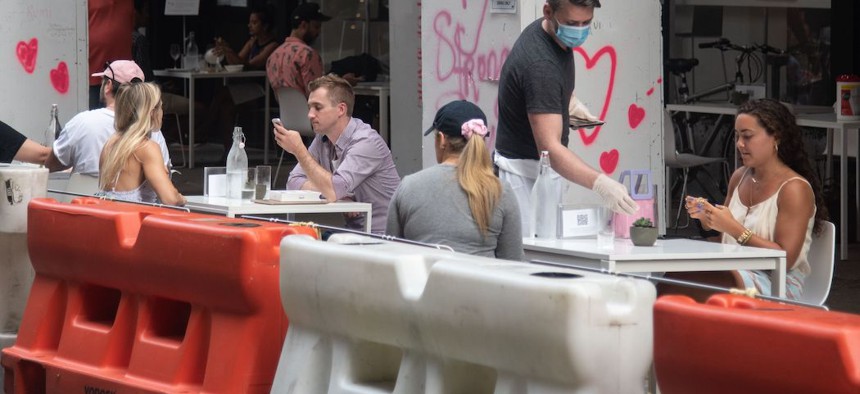Health Care (Archived)
Young people are becoming a bigger share of coronavirus infections
What the “revolving core” of COVID-19 says about infections in New York.

People dining outdoors in NYC on July 8th. Erik Pendzich /Shuttesrtock
The coronavirus pandemic has included shifting epicenters, a rolling apex and at least one figurative mountain to climb. Add to this bag of metaphors what could be called the “revolving core” of COVID-19 cases in New York City.
Young people in relatively affluent and whiter areas of the city are catching the coronavirus at increasing rates compared to other age groups, The Wall Street Journal reports. This marks a big change from the first months of the pandemic when older people and minority residents disproportionately bore the brunt of the public health crisis.
The reasons behind this shifting core demographic of cases are still a matter of scientific debate – but complacency appears to be a significant factor. Quarantine fatigue is real, and some young people just want to go out. “When you’re in a club, you’re not really thinking about what’s going on outside, which I think is the goal,” one DJ told Gothamist. “We all want to pretend this isn’t happening, but just because we’re not looking at it doesn’t mean it’s not happening.” The only problem is that young people – while less likely to die from COVID-19 than older people – can still get sick and unknowingly spread the virus to others.
The ideal conditions for spreading the coronavirus appear at the places where the youthful impulses for socialization meets city businesses desperate for income. Social media has lit up in recent days with videos and photos of maskless revelers crowding in places like the Williamsburg Hotel in Brooklyn and Ravel Hotel in Long Island City, Queens.
Similar conditions have helped to drive surge in cases in Florida, California and other areas as the death toll mounts nationwide. And while young people are becoming the core demographic for infections now, that could change as older and more vulnerable populations come into contact with younger people in the coming months.
Public health experts say that means a harm reduction approach could go a long way to mitigating the spread of the coronavirus among young people, mirroring the same strategy that officials use with teen pregnancy, drug addiction and reducing the spread of HIV/AIDS. “As we move beyond social abstinence, we must accept the new realities of our changed lives and modify our behaviors to keep ourselves and others safe,” reads one June 2020 study by NYU Langone Health that suggests a harm reduction approach could work with the coronavirus as well.
While Gov. Andrew Cuomo has highlighted state efforts to enforce social distancing at bars and restaurants, he has said local officials are really the ones who are responsible for enforcement. For now, it appears that New York City is leaning more on public outreach than police crackdowns to curb the rate of spread among young people.
“Let’s face it, it’s harder in many ways on younger people,” New York City Mayor Bill de Blasio said of the pandemic on Tuesday. “We’ve got to double-down our efforts to remind people that they’re far from impervious and, of course, it’s not just their own health, it’s the impact they could have on those around them.”
To be sure, there are other reasons why the coronavirus might be spreading among young people. More and more of them are heading back into offices and other workplaces as the city continues its reopening process. Recent protests against systemic racism also coincide with some of this increase. There are also reasons to believe that social unrest has even convinced some older people to stay inside longer than the official state stay-at-home order mandated.
Yet, as the pandemic continues to ravage the country, the ongoing surge of infections among young people suggests that the coronavirus is hardly going away in New York, one of the few states where the pandemic appears to be under control. That means suggestions of victory over the first wave of the pandemic might have been premature after all.

NEXT STORY: How NY is preparing for its next COVID-19 outbreak